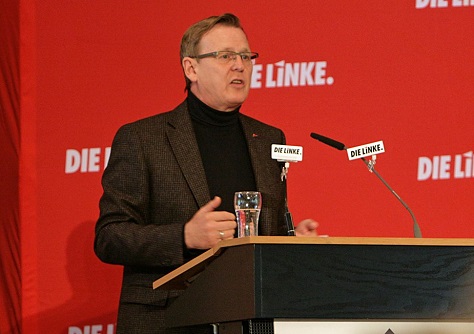After months of inter-party negotiations, the east-central German state of Thuringia will have a government led by Bodo Ramelow, the state leader of the democratic socialist Die Linke (Left Party).![]()
![]()
On the surface, it means that Die Linke, partially the successor to Socialist Unity Party (SED) that ruled the eastern German Democratic Republic, will control a state government for the first time since reunification, which has bred a significant amount of controversy:
Never before in a fully democratic Germany has a regional election triggered so much protest, with thousands demonstrating outside the parliament in Erfurt on Thursday evening ahead of the vote, declaring that the “perpetrators” were heading back into office.
Demonstrators included former East German dissidents, some of whom had spent time behind bars for their opposition views. They shouted “Stasi out!” in reference to East Germany’s repressive secret police, and “The Social Democrats have betrayed us”.
Even center-right chancellor Angela Merkel has used stark language to reject a Left-led government, arguing that Ramelow’s victory is equivalent to putting Karl Marx in charge of government.
But that’s a fairly oversimplified narrative.
Ramelow and the Left will govern in coalition with two far more moderate center-left parties, the Die Grünen (the Greens) and the Sozialdemokratische Partei Deutschlands (SPD, Social Democratic Party). The SPD, nationally, governs in a ‘grand coalition’ with chancellor Merkel’s conservative Christlich Demokratische Union Deutschlands (CDU, Christian Democratic Union).
Moreover, the Left isn’t even the largest party in the Thuringia Landtag, the regional assembly:
Far from bringing a police state or a socialist revolution to the tranquil streets of sleepy Erfurt, the Left will be governing in coalition with two far more moderate partners. With the support of the Greens and the SPD, Ramelow’s government will have a one-vote margin in the Landtag. So even if it wanted to introduce radical far-left measures, the Left wouldn’t get very far.
* * * * *
RELATED: Thuringia and Brandenburg results: Left & AfD on the rise
RELATED: Left hopes to make eastern breakthrough
in German state elections
* * * * *
It’s not clear, however, that it wants to do so. Thuringia provides the party with the opportunity that it can govern responsibly, even with a different ideological perspective than Merkel’s prevailing CDU or the moderate SPD. While the Left is relatively pro-Russia, plenty of former chancellors, from Gerhard Schröder to Helmut Kohl, have struck more lenient views toward Russia than most European figures. While the Left is also anti-NATO, that’s because it’s on the more ultra-pacifist side of a political culture that for decades has been incredibly pacifist.
Ramelow, a Lutheran union leader born in West Germany, is hardly a flamethrower, and he’s an advocate of pro-growth, anti-austerity policies. He’s called for wider investment in education and wants to provide a free year of kindergarten to every child in the state.
That’s not exactly the coming of the 21st century Marxist vanguard, but Ramelow has strained to convince skeptics that the Left is not an artifact of East Germany:
Ramelow has said he is no apologist, stating: “I’m not a representative of the East German regime and neither is my party a bunch of nostalgists who want to resurrect it.”
It’s also not the first time that the SPD and the Left have formed coalitions. A so-called ‘red-red’ coalition currently governs Brandenburg, following elections earlier this summer as well, and similar coalitions have governed Berlin, Saxony-Anhalt and Mecklenburg-Vorpommern, some as long ago as 1994.
The difference is that, this time, it’s the Left that will be the senior partner in the government, not the SPD.
From Merkel’s perspective, one suspects her worry is less ideological than strategic. As the SPD gets increasingly comfortable governing with the Left, there’s an increasingly likelihood that a ‘Red-Red-Green’ coalition of Germany’s three left-leaning parties could control the national government. Today, for example, if the SPD decided to leave government with Merkel, it could wield a (small) majority with the Left and the Greens in the lower house of the German parliament, the Bundestag.
No one is suggesting that — for now. But it’s becoming clearer that the German left’s path back to power will require tripartite unity, even if the Left doesn’t formally enter government (but, instead, provides support to an SPD-led coalition from outside government).
Last month, Germany celebrated the 25th anniversary since the fall of the Berlin Wall, so Germany’s current Left Party isn’t simply an unreconstructed version of the old Socialist Unity Party. In the 1990s, the Left existed in the form of the Partei des Demokratischen Sozialismus (Party of Democratic Socialism) and, like today, draws most of its support from what used to be East Germany. In 2005, however, Oskar Lafontaine, a former SPD chairman and finance minister under Schröder, split from the SPD over the Hartz IV reforms that significantly liberalized German labor laws and reduced unemployment benefits. Lafontaine’s band of left-wing SPD rebels partnered with the Democratic Socialists, giving a base of western support to what was almost exclusively an eastern party. The two groups formally merged in 2007 to form the Left Party.
Critics are busy talking about the Left Party and Germany’s past, and that’s a relevant conversation, especially so soon after marking the Berlin Wall milestone. But the German left, in general, should have its eye firmly on a future that incorporates the Left Party as a potential partner in government.

